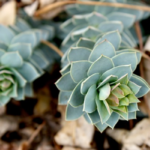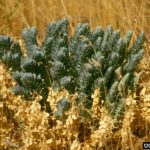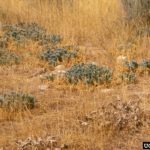Gallery:
- Myrtle spurge
- Myrtle spurge
- Myrtle spurge flowers and bracts
- Myrtle spurge invading a field
Common names:
Myrtle spurge, donkey tail, blue spurge, creeping spurge
Scientific Name:
Euphorbia myrsinites
Description:
Myrtle spurge is a low-growing perennial plant in the Euphorbiaceae (spurge) family. It is a garden ornamental that escaped cultivation and has spread to natural areas. It grows close to the ground and exudes a toxic milky sap when any part is broken. The flowers are small, yellow, and somewhat inconspicuous, but are surrounded by more showy yellow-green heart-shaped bracts. The leaves are succulent, blue-green, and arranged in close spirals. It spreads by root fragments and small seeds which can be ejected up to 15 feet when the plant is disturbed. Seeds can survive in the soil for 8 years.
Life cycle:
Height of mature plants
4-8 inches
Flower color:
yellow to yellowish-green
Bloom time:
March to April
Look-a-likes:
Myrtle spurge is quite distinct from other plants. The flowers and bracts of myrtle spurge look similar to other spurges. However, the succulent leaves of myrtle spurge are unique. Myrtle spurge also looks a bit similar to dalmatian toadflax. However, the flowers on toadflax are quite different, as they are two lipped, resembling snapdragons. Dalmatian toadflax is also upright.
Habitat:
Myrtle spurge generally prefers full sun and well drained soils. It can be found in gardens, fields, waste places, roadsides, natural areas, and rocky slopes
Impacts:
Myrtle spurge will invade disturbed ground and out compete native plants. Seeds can be ejected when plants are disturbed, sticking to wildlife hair and enabling transport far from the parent plant. Aside from displacing desirable native species, the plant invades playgrounds and parks in some states.When any part is broken, it excuses a milky sap which is poisonous when ingested and a severe irritant to skin and eyes.
Noxious Weed Listing:
- WeedWise: maintenance
- State of Oregon: Class B
- State of Washington: Class B
- Four County CWMA: Class E
- Columbia Gorge CWMA: Class B
Origin:
Western Asia, southern and eastern Europe
Links:
Oregon Noxious Weed Profile
Washington Noxious Weed Profile
Washington State Fact Sheet
Invasive.org profile




